Sustainable Engineering: Waste Management and Green Practice Report
VerifiedAdded on 2020/03/28
|12
|2651
|149
Report
AI Summary
This report delves into the principles of sustainable engineering, emphasizing the critical role of waste management and green practices. It begins by defining sustainable engineering and its objectives, highlighting the importance of minimizing environmental degradation caused by engineering projects. The report then explores the factors influencing sustainability and the necessity of effective waste management techniques across various engineering disciplines. It examines the different categories of waste and their potential impact on human health and the environment, including the specific challenges posed by nuclear waste and municipal solid waste. Furthermore, the report discusses green engineering practices, such as minimizing the use of hazardous substances, reducing waste generation, and implementing energy-efficient technologies. It emphasizes the importance of material selection, the concepts of lifecycle and the application of the 3Rs (Reduce, Reuse, Recycle) to promote sustainable development. The report concludes by underscoring the significance of sustainable engineering for protecting future generations and ensuring economic and environmental balance. It highlights the need for proper waste management techniques, including the implementation of green engineering practices and the enforcement of supportive government policies.
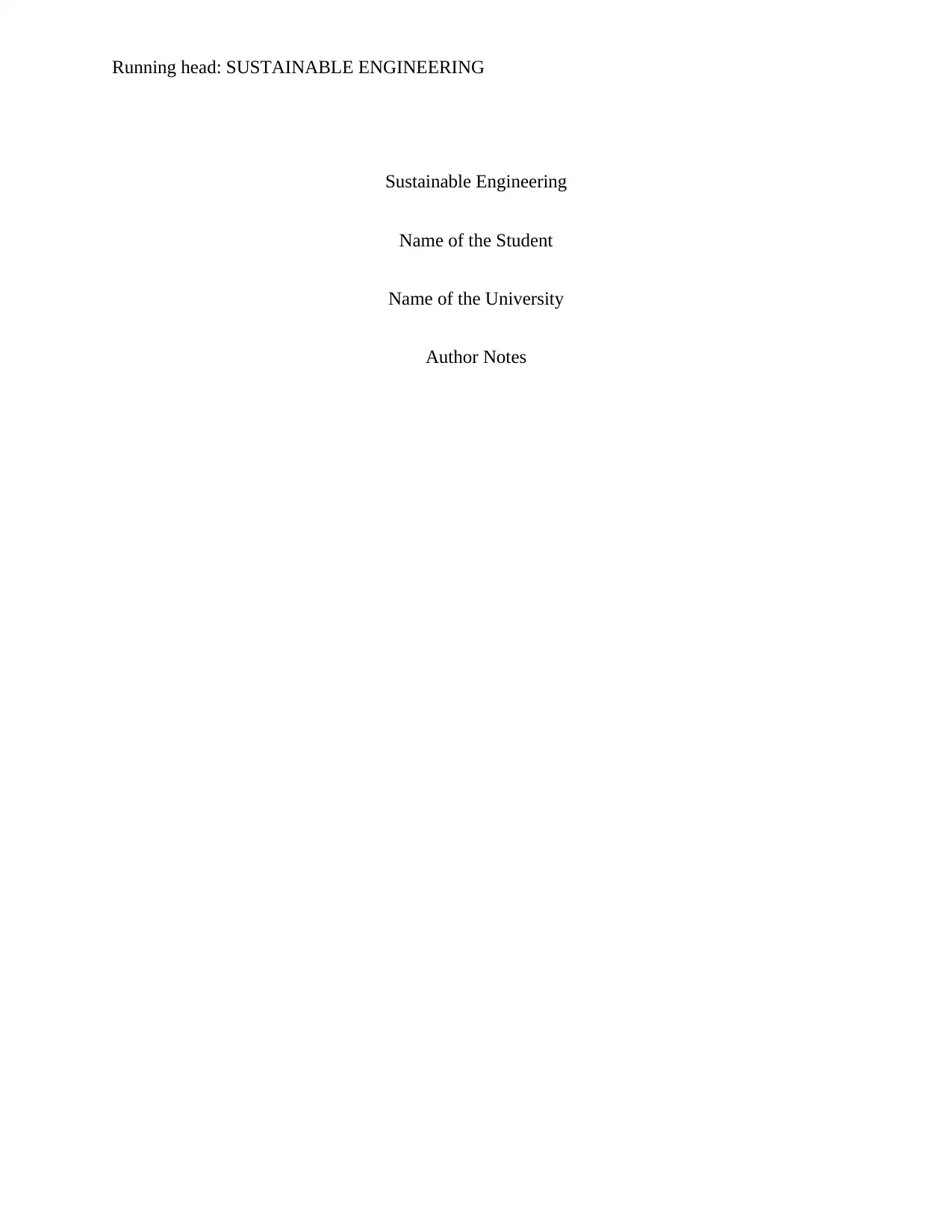
Running head: SUSTAINABLE ENGINEERING
Sustainable Engineering
Name of the Student
Name of the University
Author Notes
Sustainable Engineering
Name of the Student
Name of the University
Author Notes
Paraphrase This Document
Need a fresh take? Get an instant paraphrase of this document with our AI Paraphraser
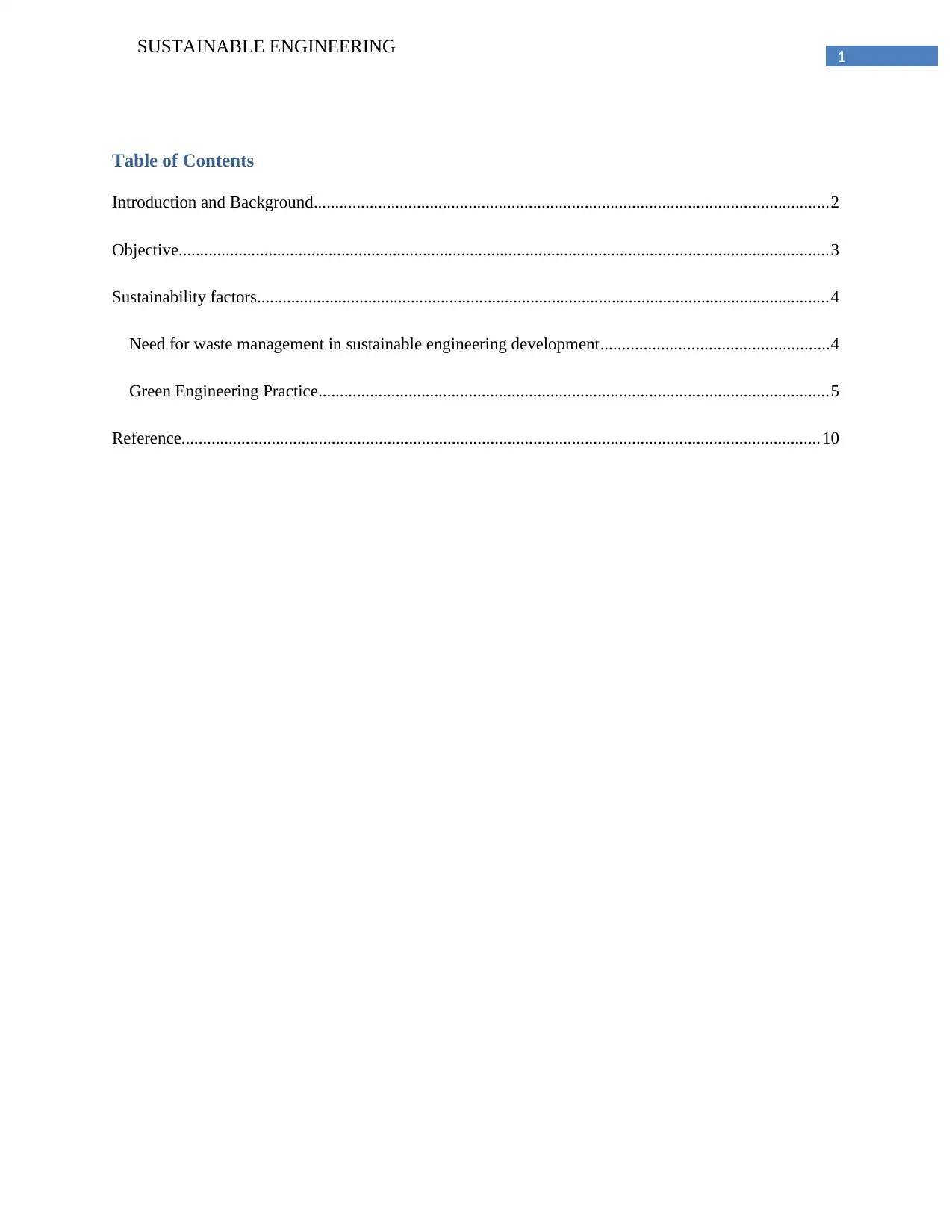
1
SUSTAINABLE ENGINEERING
Table of Contents
Introduction and Background........................................................................................................................2
Objective........................................................................................................................................................3
Sustainability factors......................................................................................................................................4
Need for waste management in sustainable engineering development.....................................................4
Green Engineering Practice.......................................................................................................................5
Reference.....................................................................................................................................................10
SUSTAINABLE ENGINEERING
Table of Contents
Introduction and Background........................................................................................................................2
Objective........................................................................................................................................................3
Sustainability factors......................................................................................................................................4
Need for waste management in sustainable engineering development.....................................................4
Green Engineering Practice.......................................................................................................................5
Reference.....................................................................................................................................................10
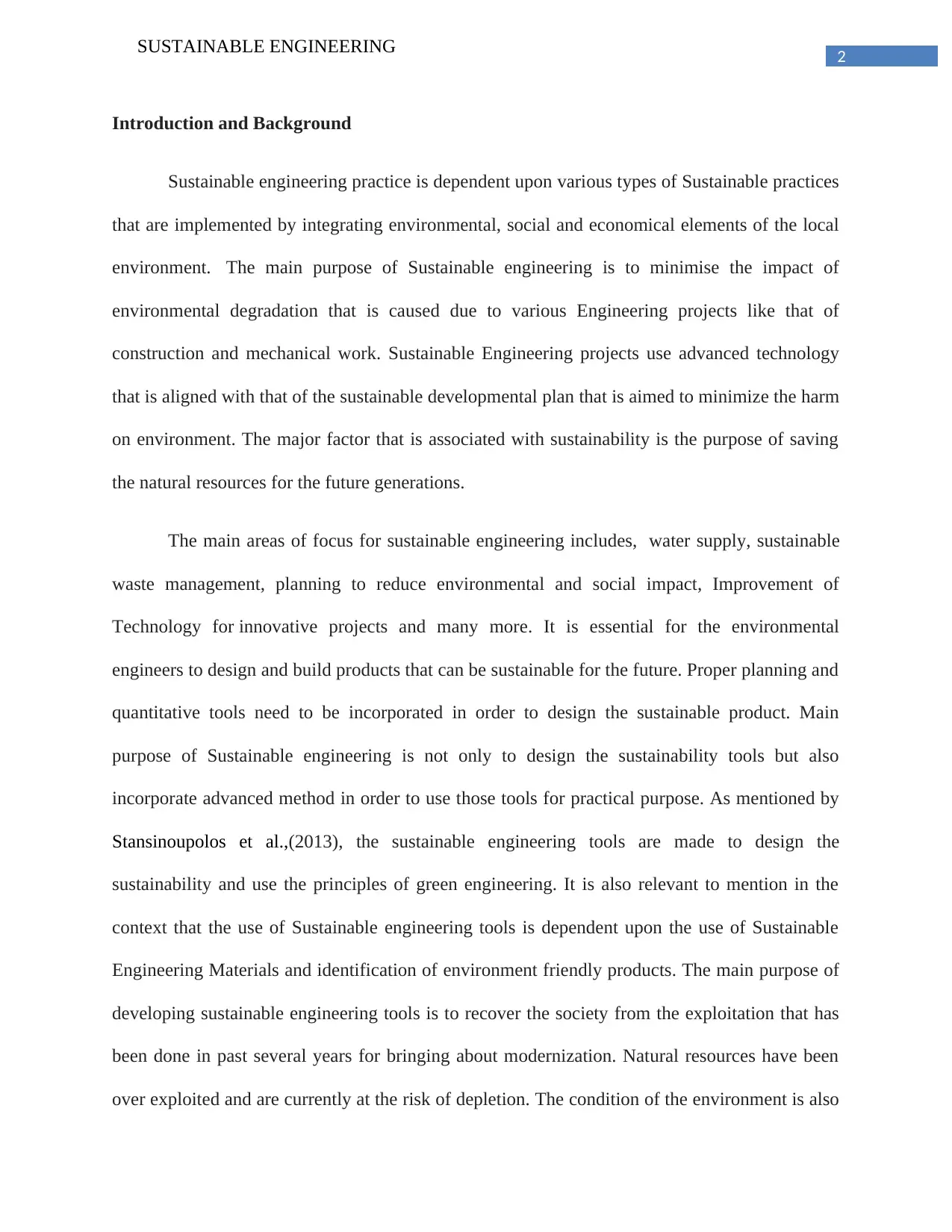
2
SUSTAINABLE ENGINEERING
Introduction and Background
Sustainable engineering practice is dependent upon various types of Sustainable practices
that are implemented by integrating environmental, social and economical elements of the local
environment. The main purpose of Sustainable engineering is to minimise the impact of
environmental degradation that is caused due to various Engineering projects like that of
construction and mechanical work. Sustainable Engineering projects use advanced technology
that is aligned with that of the sustainable developmental plan that is aimed to minimize the harm
on environment. The major factor that is associated with sustainability is the purpose of saving
the natural resources for the future generations.
The main areas of focus for sustainable engineering includes, water supply, sustainable
waste management, planning to reduce environmental and social impact, Improvement of
Technology for innovative projects and many more. It is essential for the environmental
engineers to design and build products that can be sustainable for the future. Proper planning and
quantitative tools need to be incorporated in order to design the sustainable product. Main
purpose of Sustainable engineering is not only to design the sustainability tools but also
incorporate advanced method in order to use those tools for practical purpose. As mentioned by
Stansinoupolos et al.,(2013), the sustainable engineering tools are made to design the
sustainability and use the principles of green engineering. It is also relevant to mention in the
context that the use of Sustainable engineering tools is dependent upon the use of Sustainable
Engineering Materials and identification of environment friendly products. The main purpose of
developing sustainable engineering tools is to recover the society from the exploitation that has
been done in past several years for bringing about modernization. Natural resources have been
over exploited and are currently at the risk of depletion. The condition of the environment is also
SUSTAINABLE ENGINEERING
Introduction and Background
Sustainable engineering practice is dependent upon various types of Sustainable practices
that are implemented by integrating environmental, social and economical elements of the local
environment. The main purpose of Sustainable engineering is to minimise the impact of
environmental degradation that is caused due to various Engineering projects like that of
construction and mechanical work. Sustainable Engineering projects use advanced technology
that is aligned with that of the sustainable developmental plan that is aimed to minimize the harm
on environment. The major factor that is associated with sustainability is the purpose of saving
the natural resources for the future generations.
The main areas of focus for sustainable engineering includes, water supply, sustainable
waste management, planning to reduce environmental and social impact, Improvement of
Technology for innovative projects and many more. It is essential for the environmental
engineers to design and build products that can be sustainable for the future. Proper planning and
quantitative tools need to be incorporated in order to design the sustainable product. Main
purpose of Sustainable engineering is not only to design the sustainability tools but also
incorporate advanced method in order to use those tools for practical purpose. As mentioned by
Stansinoupolos et al.,(2013), the sustainable engineering tools are made to design the
sustainability and use the principles of green engineering. It is also relevant to mention in the
context that the use of Sustainable engineering tools is dependent upon the use of Sustainable
Engineering Materials and identification of environment friendly products. The main purpose of
developing sustainable engineering tools is to recover the society from the exploitation that has
been done in past several years for bringing about modernization. Natural resources have been
over exploited and are currently at the risk of depletion. The condition of the environment is also
⊘ This is a preview!⊘
Do you want full access?
Subscribe today to unlock all pages.

Trusted by 1+ million students worldwide
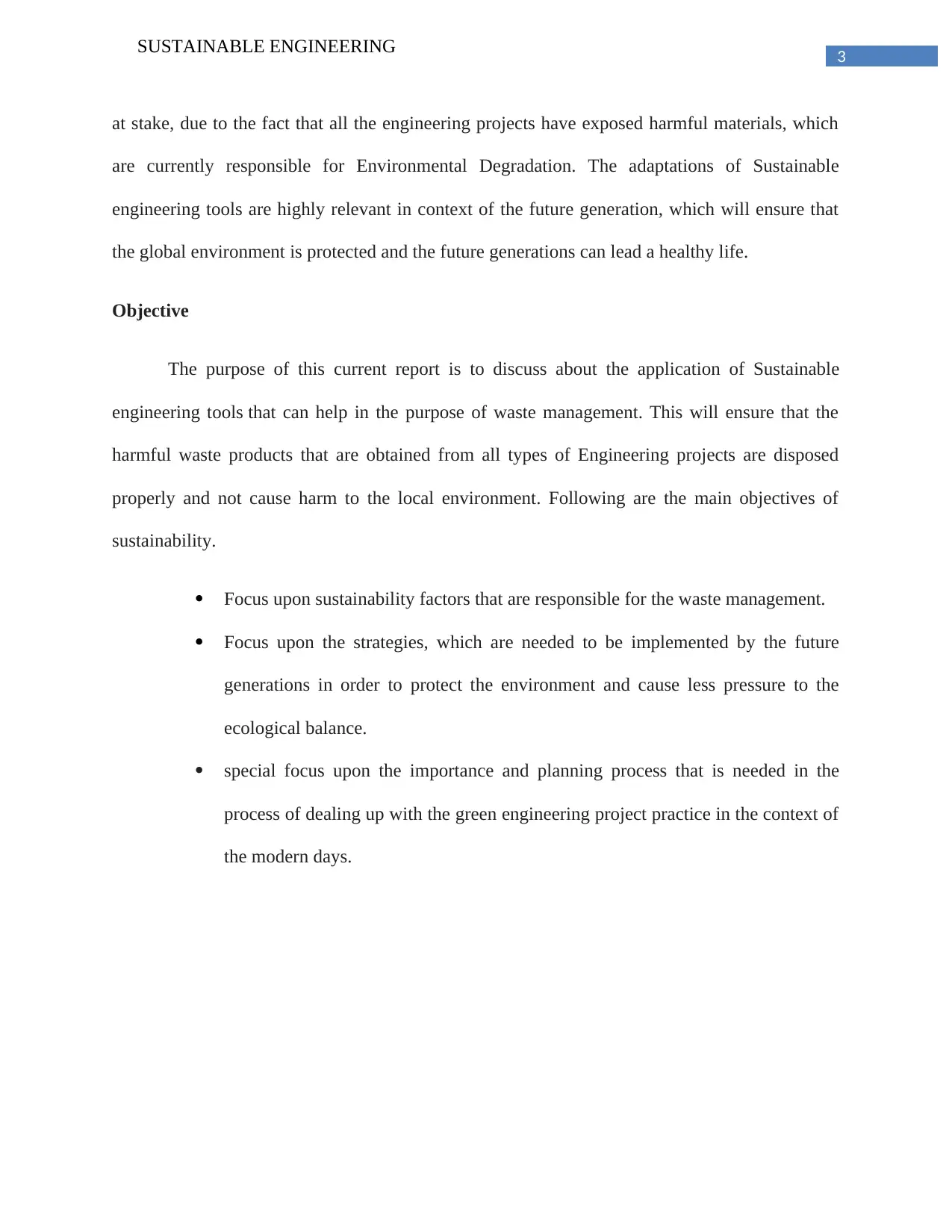
3
SUSTAINABLE ENGINEERING
at stake, due to the fact that all the engineering projects have exposed harmful materials, which
are currently responsible for Environmental Degradation. The adaptations of Sustainable
engineering tools are highly relevant in context of the future generation, which will ensure that
the global environment is protected and the future generations can lead a healthy life.
Objective
The purpose of this current report is to discuss about the application of Sustainable
engineering tools that can help in the purpose of waste management. This will ensure that the
harmful waste products that are obtained from all types of Engineering projects are disposed
properly and not cause harm to the local environment. Following are the main objectives of
sustainability.
Focus upon sustainability factors that are responsible for the waste management.
Focus upon the strategies, which are needed to be implemented by the future
generations in order to protect the environment and cause less pressure to the
ecological balance.
special focus upon the importance and planning process that is needed in the
process of dealing up with the green engineering project practice in the context of
the modern days.
SUSTAINABLE ENGINEERING
at stake, due to the fact that all the engineering projects have exposed harmful materials, which
are currently responsible for Environmental Degradation. The adaptations of Sustainable
engineering tools are highly relevant in context of the future generation, which will ensure that
the global environment is protected and the future generations can lead a healthy life.
Objective
The purpose of this current report is to discuss about the application of Sustainable
engineering tools that can help in the purpose of waste management. This will ensure that the
harmful waste products that are obtained from all types of Engineering projects are disposed
properly and not cause harm to the local environment. Following are the main objectives of
sustainability.
Focus upon sustainability factors that are responsible for the waste management.
Focus upon the strategies, which are needed to be implemented by the future
generations in order to protect the environment and cause less pressure to the
ecological balance.
special focus upon the importance and planning process that is needed in the
process of dealing up with the green engineering project practice in the context of
the modern days.
Paraphrase This Document
Need a fresh take? Get an instant paraphrase of this document with our AI Paraphraser

4
SUSTAINABLE ENGINEERING
Sustainability factors
Need for waste management in sustainable engineering development
With all types of Engineering projects, which are involved in the disposal of various
types of wastes, it is essential to have proper waste management techniques. This can ensure that
minimum amount of harm is caused to the local environment. Hanes, andBakshi (2015), have
mentioned that there are different kinds and categories of waste, which are exposed from all
types of engineering projects. It is essential to have proper waste management techniques for
each category, which will ensure proper sustainability and minimum harm to all the biological
elements. Waste management techniques also include all the proper steps that are needed to
manage waste and finally dispose the same, without causing any damage to people or
environment.
As per mentioned in the report of Yue, and You (2013), the waste material from all types
of Engineering projects, which includes various types of toxic elements can cause direct harm to
the people, who are involved in the project activities. For example the nuclear or radioactive
waste materials which are produced from engineering projects are directly responsible for
various types of skin and breathing problems among the human population. Long term exposure
to nuclear waste, can also cause permanent damages to human health that can include exposure
to carcinogenic agents. Direct disposal of the nuclear waste can also cause harm to the local
environment due to the fact that most of the Biological agents are highly harmed due to the
effects of the nuclear wastes.
It is important to mention in the context that with the rise in the demand of electricity
energy, it is essential for the modern society to depend upon the usage of the nuclear power,
SUSTAINABLE ENGINEERING
Sustainability factors
Need for waste management in sustainable engineering development
With all types of Engineering projects, which are involved in the disposal of various
types of wastes, it is essential to have proper waste management techniques. This can ensure that
minimum amount of harm is caused to the local environment. Hanes, andBakshi (2015), have
mentioned that there are different kinds and categories of waste, which are exposed from all
types of engineering projects. It is essential to have proper waste management techniques for
each category, which will ensure proper sustainability and minimum harm to all the biological
elements. Waste management techniques also include all the proper steps that are needed to
manage waste and finally dispose the same, without causing any damage to people or
environment.
As per mentioned in the report of Yue, and You (2013), the waste material from all types
of Engineering projects, which includes various types of toxic elements can cause direct harm to
the people, who are involved in the project activities. For example the nuclear or radioactive
waste materials which are produced from engineering projects are directly responsible for
various types of skin and breathing problems among the human population. Long term exposure
to nuclear waste, can also cause permanent damages to human health that can include exposure
to carcinogenic agents. Direct disposal of the nuclear waste can also cause harm to the local
environment due to the fact that most of the Biological agents are highly harmed due to the
effects of the nuclear wastes.
It is important to mention in the context that with the rise in the demand of electricity
energy, it is essential for the modern society to depend upon the usage of the nuclear power,
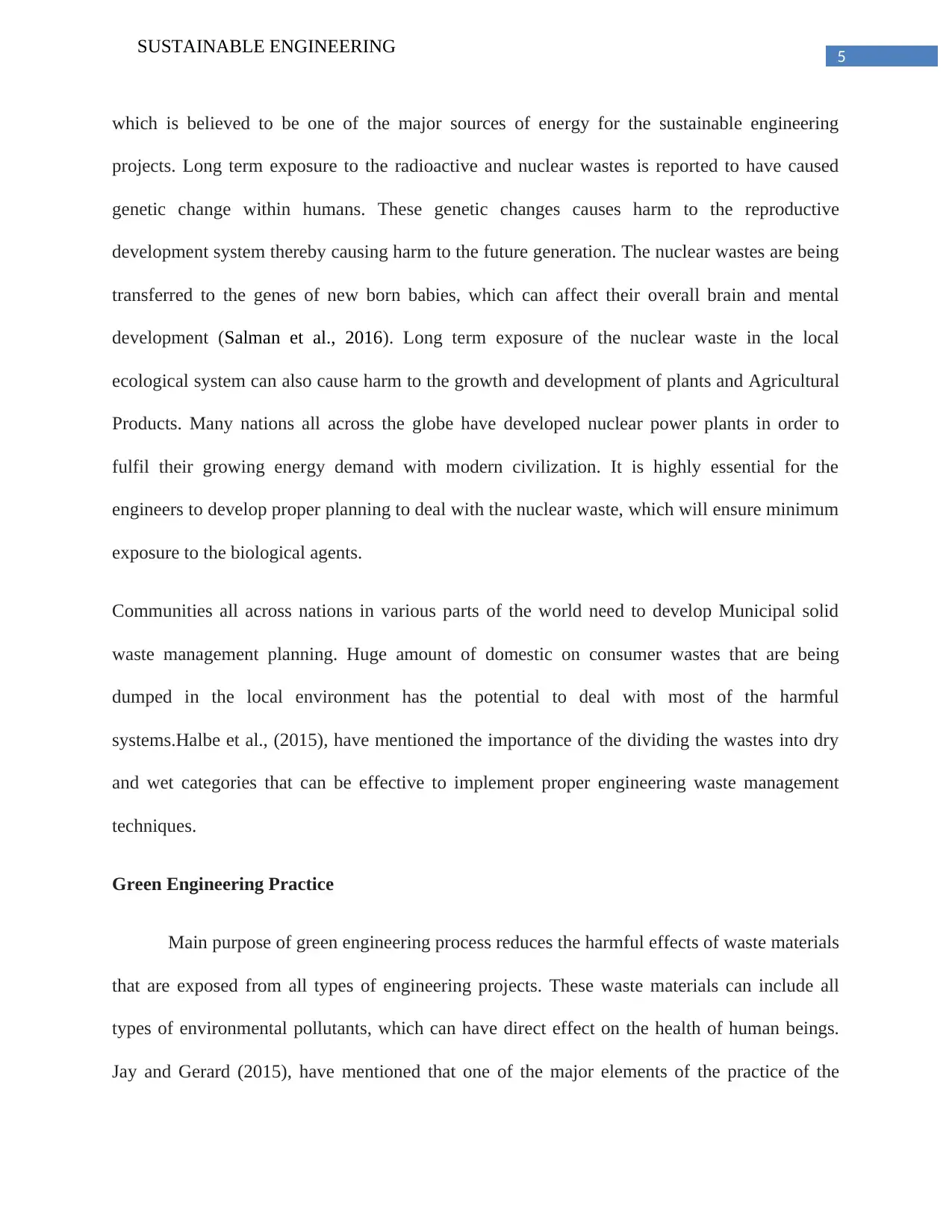
5
SUSTAINABLE ENGINEERING
which is believed to be one of the major sources of energy for the sustainable engineering
projects. Long term exposure to the radioactive and nuclear wastes is reported to have caused
genetic change within humans. These genetic changes causes harm to the reproductive
development system thereby causing harm to the future generation. The nuclear wastes are being
transferred to the genes of new born babies, which can affect their overall brain and mental
development (Salman et al., 2016). Long term exposure of the nuclear waste in the local
ecological system can also cause harm to the growth and development of plants and Agricultural
Products. Many nations all across the globe have developed nuclear power plants in order to
fulfil their growing energy demand with modern civilization. It is highly essential for the
engineers to develop proper planning to deal with the nuclear waste, which will ensure minimum
exposure to the biological agents.
Communities all across nations in various parts of the world need to develop Municipal solid
waste management planning. Huge amount of domestic on consumer wastes that are being
dumped in the local environment has the potential to deal with most of the harmful
systems.Halbe et al., (2015), have mentioned the importance of the dividing the wastes into dry
and wet categories that can be effective to implement proper engineering waste management
techniques.
Green Engineering Practice
Main purpose of green engineering process reduces the harmful effects of waste materials
that are exposed from all types of engineering projects. These waste materials can include all
types of environmental pollutants, which can have direct effect on the health of human beings.
Jay and Gerard (2015), have mentioned that one of the major elements of the practice of the
SUSTAINABLE ENGINEERING
which is believed to be one of the major sources of energy for the sustainable engineering
projects. Long term exposure to the radioactive and nuclear wastes is reported to have caused
genetic change within humans. These genetic changes causes harm to the reproductive
development system thereby causing harm to the future generation. The nuclear wastes are being
transferred to the genes of new born babies, which can affect their overall brain and mental
development (Salman et al., 2016). Long term exposure of the nuclear waste in the local
ecological system can also cause harm to the growth and development of plants and Agricultural
Products. Many nations all across the globe have developed nuclear power plants in order to
fulfil their growing energy demand with modern civilization. It is highly essential for the
engineers to develop proper planning to deal with the nuclear waste, which will ensure minimum
exposure to the biological agents.
Communities all across nations in various parts of the world need to develop Municipal solid
waste management planning. Huge amount of domestic on consumer wastes that are being
dumped in the local environment has the potential to deal with most of the harmful
systems.Halbe et al., (2015), have mentioned the importance of the dividing the wastes into dry
and wet categories that can be effective to implement proper engineering waste management
techniques.
Green Engineering Practice
Main purpose of green engineering process reduces the harmful effects of waste materials
that are exposed from all types of engineering projects. These waste materials can include all
types of environmental pollutants, which can have direct effect on the health of human beings.
Jay and Gerard (2015), have mentioned that one of the major elements of the practice of the
⊘ This is a preview!⊘
Do you want full access?
Subscribe today to unlock all pages.

Trusted by 1+ million students worldwide
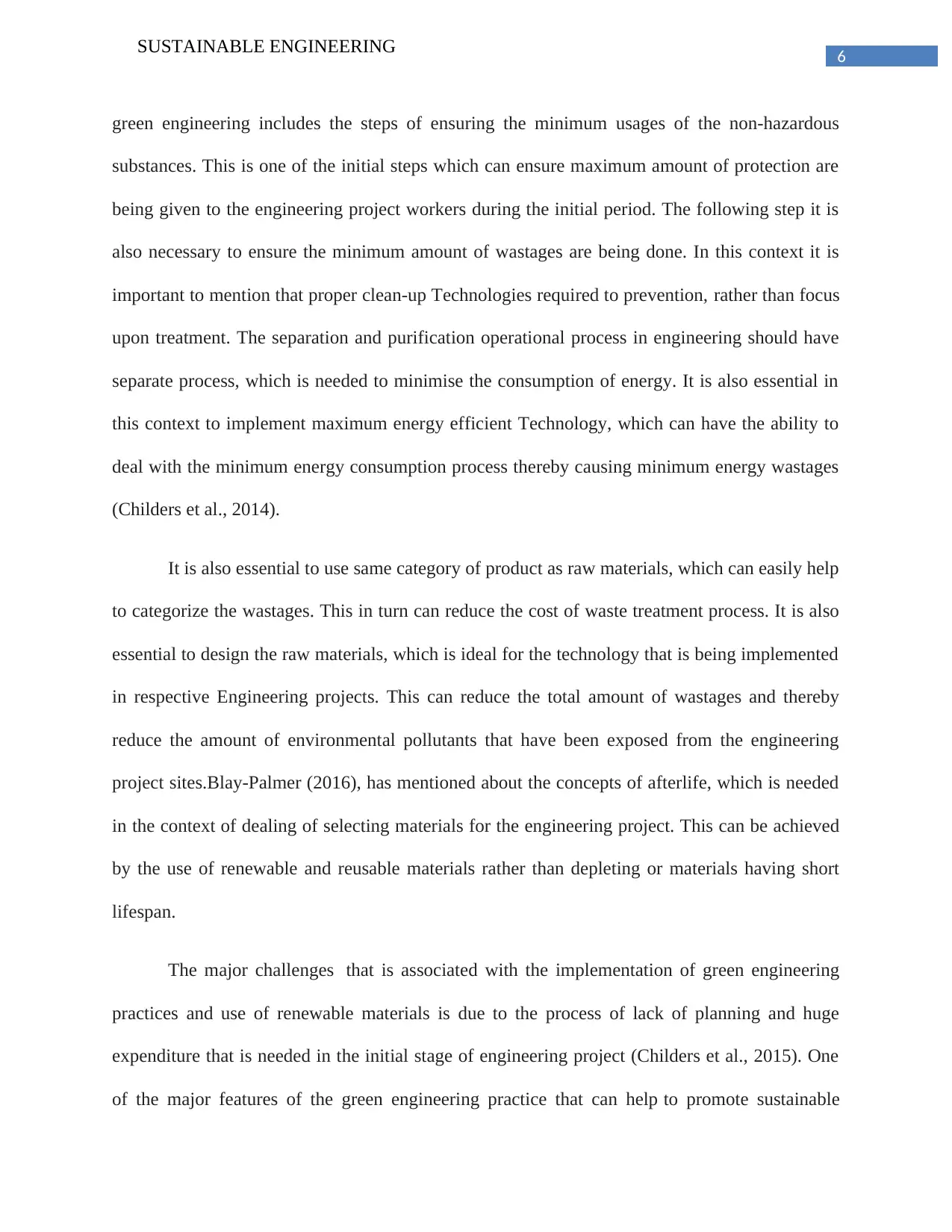
6
SUSTAINABLE ENGINEERING
green engineering includes the steps of ensuring the minimum usages of the non-hazardous
substances. This is one of the initial steps which can ensure maximum amount of protection are
being given to the engineering project workers during the initial period. The following step it is
also necessary to ensure the minimum amount of wastages are being done. In this context it is
important to mention that proper clean-up Technologies required to prevention, rather than focus
upon treatment. The separation and purification operational process in engineering should have
separate process, which is needed to minimise the consumption of energy. It is also essential in
this context to implement maximum energy efficient Technology, which can have the ability to
deal with the minimum energy consumption process thereby causing minimum energy wastages
(Childers et al., 2014).
It is also essential to use same category of product as raw materials, which can easily help
to categorize the wastages. This in turn can reduce the cost of waste treatment process. It is also
essential to design the raw materials, which is ideal for the technology that is being implemented
in respective Engineering projects. This can reduce the total amount of wastages and thereby
reduce the amount of environmental pollutants that have been exposed from the engineering
project sites.Blay-Palmer (2016), has mentioned about the concepts of afterlife, which is needed
in the context of dealing of selecting materials for the engineering project. This can be achieved
by the use of renewable and reusable materials rather than depleting or materials having short
lifespan.
The major challenges that is associated with the implementation of green engineering
practices and use of renewable materials is due to the process of lack of planning and huge
expenditure that is needed in the initial stage of engineering project (Childers et al., 2015). One
of the major features of the green engineering practice that can help to promote sustainable
SUSTAINABLE ENGINEERING
green engineering includes the steps of ensuring the minimum usages of the non-hazardous
substances. This is one of the initial steps which can ensure maximum amount of protection are
being given to the engineering project workers during the initial period. The following step it is
also necessary to ensure the minimum amount of wastages are being done. In this context it is
important to mention that proper clean-up Technologies required to prevention, rather than focus
upon treatment. The separation and purification operational process in engineering should have
separate process, which is needed to minimise the consumption of energy. It is also essential in
this context to implement maximum energy efficient Technology, which can have the ability to
deal with the minimum energy consumption process thereby causing minimum energy wastages
(Childers et al., 2014).
It is also essential to use same category of product as raw materials, which can easily help
to categorize the wastages. This in turn can reduce the cost of waste treatment process. It is also
essential to design the raw materials, which is ideal for the technology that is being implemented
in respective Engineering projects. This can reduce the total amount of wastages and thereby
reduce the amount of environmental pollutants that have been exposed from the engineering
project sites.Blay-Palmer (2016), has mentioned about the concepts of afterlife, which is needed
in the context of dealing of selecting materials for the engineering project. This can be achieved
by the use of renewable and reusable materials rather than depleting or materials having short
lifespan.
The major challenges that is associated with the implementation of green engineering
practices and use of renewable materials is due to the process of lack of planning and huge
expenditure that is needed in the initial stage of engineering project (Childers et al., 2015). One
of the major features of the green engineering practice that can help to promote sustainable
Paraphrase This Document
Need a fresh take? Get an instant paraphrase of this document with our AI Paraphraser
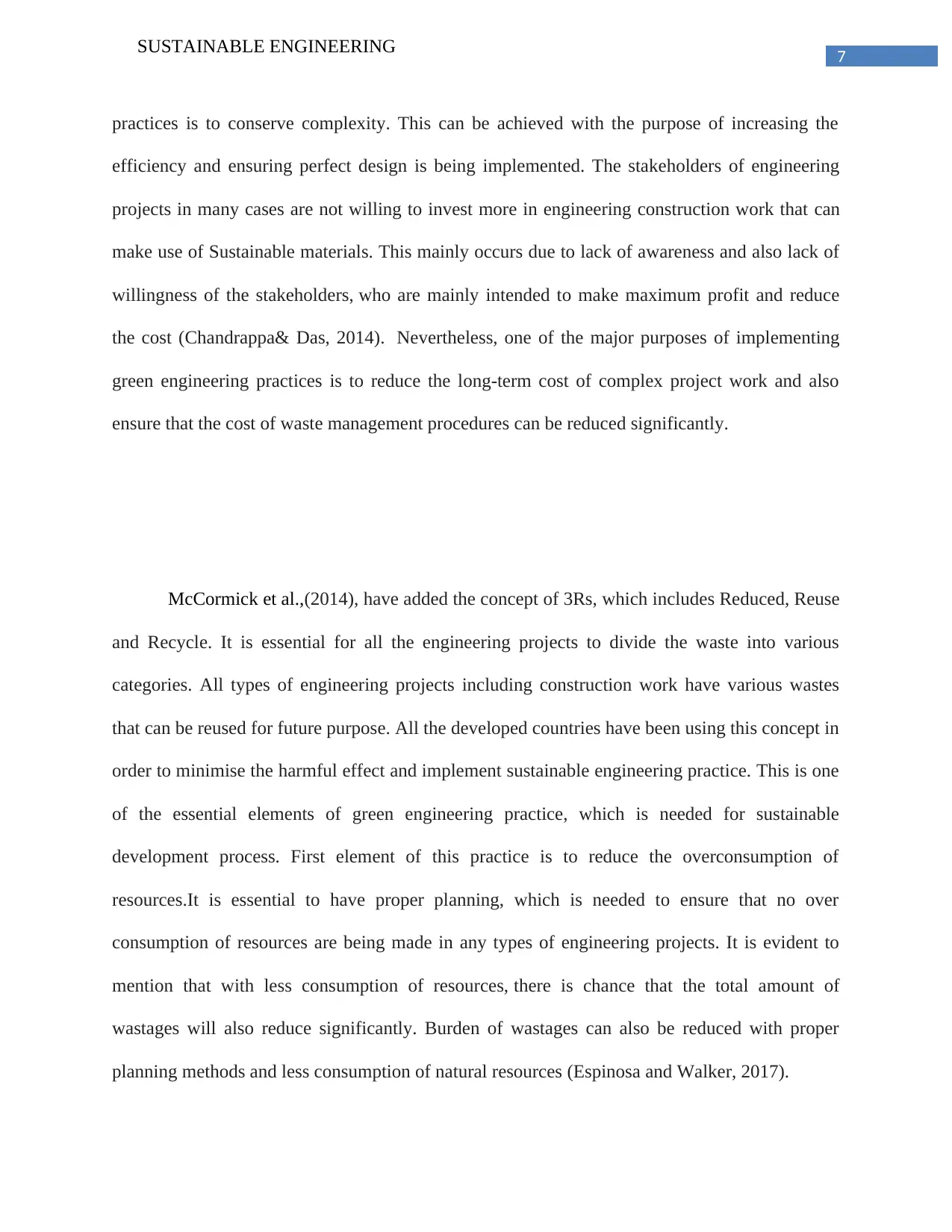
7
SUSTAINABLE ENGINEERING
practices is to conserve complexity. This can be achieved with the purpose of increasing the
efficiency and ensuring perfect design is being implemented. The stakeholders of engineering
projects in many cases are not willing to invest more in engineering construction work that can
make use of Sustainable materials. This mainly occurs due to lack of awareness and also lack of
willingness of the stakeholders, who are mainly intended to make maximum profit and reduce
the cost (Chandrappa& Das, 2014). Nevertheless, one of the major purposes of implementing
green engineering practices is to reduce the long-term cost of complex project work and also
ensure that the cost of waste management procedures can be reduced significantly.
McCormick et al.,(2014), have added the concept of 3Rs, which includes Reduced, Reuse
and Recycle. It is essential for all the engineering projects to divide the waste into various
categories. All types of engineering projects including construction work have various wastes
that can be reused for future purpose. All the developed countries have been using this concept in
order to minimise the harmful effect and implement sustainable engineering practice. This is one
of the essential elements of green engineering practice, which is needed for sustainable
development process. First element of this practice is to reduce the overconsumption of
resources.It is essential to have proper planning, which is needed to ensure that no over
consumption of resources are being made in any types of engineering projects. It is evident to
mention that with less consumption of resources, there is chance that the total amount of
wastages will also reduce significantly. Burden of wastages can also be reduced with proper
planning methods and less consumption of natural resources (Espinosa and Walker, 2017).
SUSTAINABLE ENGINEERING
practices is to conserve complexity. This can be achieved with the purpose of increasing the
efficiency and ensuring perfect design is being implemented. The stakeholders of engineering
projects in many cases are not willing to invest more in engineering construction work that can
make use of Sustainable materials. This mainly occurs due to lack of awareness and also lack of
willingness of the stakeholders, who are mainly intended to make maximum profit and reduce
the cost (Chandrappa& Das, 2014). Nevertheless, one of the major purposes of implementing
green engineering practices is to reduce the long-term cost of complex project work and also
ensure that the cost of waste management procedures can be reduced significantly.
McCormick et al.,(2014), have added the concept of 3Rs, which includes Reduced, Reuse
and Recycle. It is essential for all the engineering projects to divide the waste into various
categories. All types of engineering projects including construction work have various wastes
that can be reused for future purpose. All the developed countries have been using this concept in
order to minimise the harmful effect and implement sustainable engineering practice. This is one
of the essential elements of green engineering practice, which is needed for sustainable
development process. First element of this practice is to reduce the overconsumption of
resources.It is essential to have proper planning, which is needed to ensure that no over
consumption of resources are being made in any types of engineering projects. It is evident to
mention that with less consumption of resources, there is chance that the total amount of
wastages will also reduce significantly. Burden of wastages can also be reduced with proper
planning methods and less consumption of natural resources (Espinosa and Walker, 2017).
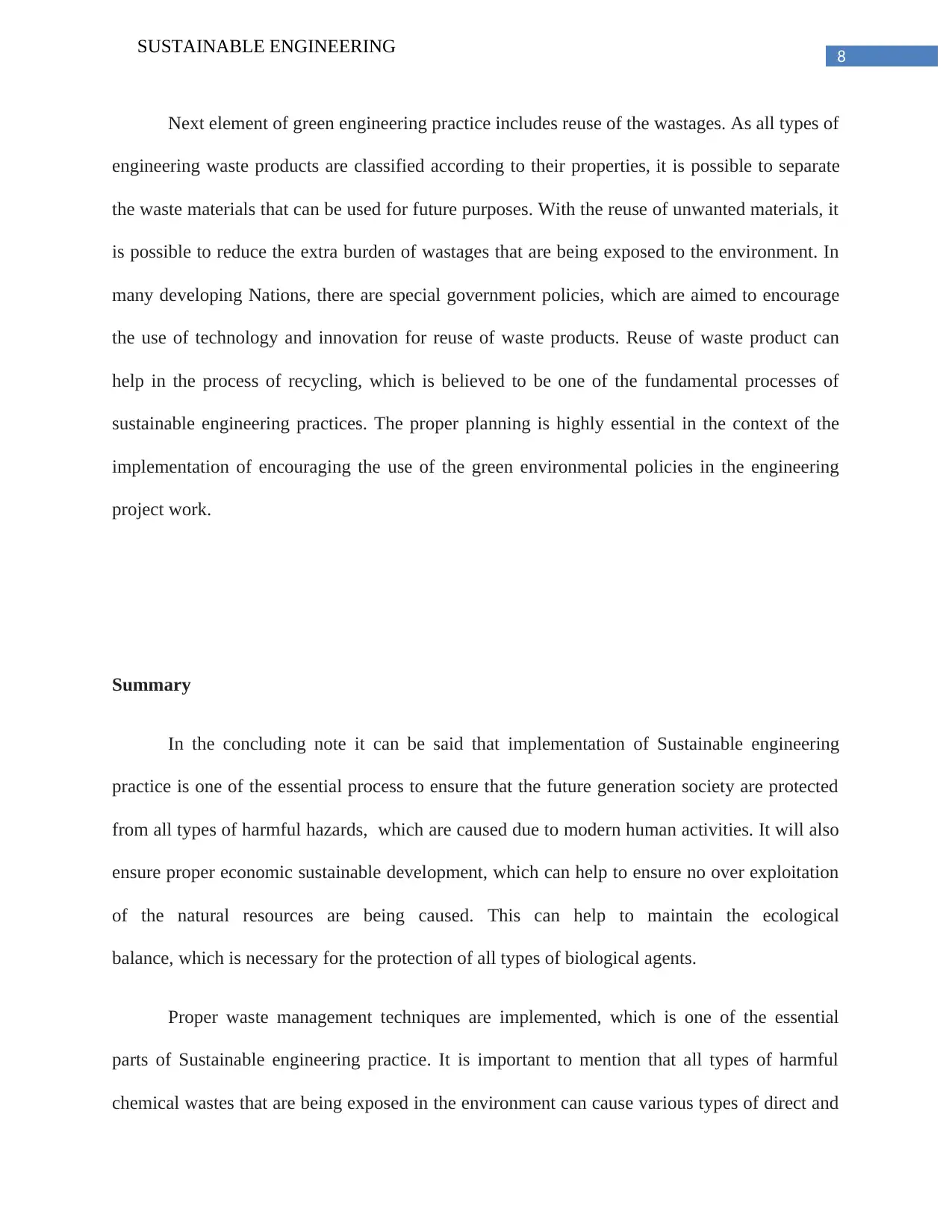
8
SUSTAINABLE ENGINEERING
Next element of green engineering practice includes reuse of the wastages. As all types of
engineering waste products are classified according to their properties, it is possible to separate
the waste materials that can be used for future purposes. With the reuse of unwanted materials, it
is possible to reduce the extra burden of wastages that are being exposed to the environment. In
many developing Nations, there are special government policies, which are aimed to encourage
the use of technology and innovation for reuse of waste products. Reuse of waste product can
help in the process of recycling, which is believed to be one of the fundamental processes of
sustainable engineering practices. The proper planning is highly essential in the context of the
implementation of encouraging the use of the green environmental policies in the engineering
project work.
Summary
In the concluding note it can be said that implementation of Sustainable engineering
practice is one of the essential process to ensure that the future generation society are protected
from all types of harmful hazards, which are caused due to modern human activities. It will also
ensure proper economic sustainable development, which can help to ensure no over exploitation
of the natural resources are being caused. This can help to maintain the ecological
balance, which is necessary for the protection of all types of biological agents.
Proper waste management techniques are implemented, which is one of the essential
parts of Sustainable engineering practice. It is important to mention that all types of harmful
chemical wastes that are being exposed in the environment can cause various types of direct and
SUSTAINABLE ENGINEERING
Next element of green engineering practice includes reuse of the wastages. As all types of
engineering waste products are classified according to their properties, it is possible to separate
the waste materials that can be used for future purposes. With the reuse of unwanted materials, it
is possible to reduce the extra burden of wastages that are being exposed to the environment. In
many developing Nations, there are special government policies, which are aimed to encourage
the use of technology and innovation for reuse of waste products. Reuse of waste product can
help in the process of recycling, which is believed to be one of the fundamental processes of
sustainable engineering practices. The proper planning is highly essential in the context of the
implementation of encouraging the use of the green environmental policies in the engineering
project work.
Summary
In the concluding note it can be said that implementation of Sustainable engineering
practice is one of the essential process to ensure that the future generation society are protected
from all types of harmful hazards, which are caused due to modern human activities. It will also
ensure proper economic sustainable development, which can help to ensure no over exploitation
of the natural resources are being caused. This can help to maintain the ecological
balance, which is necessary for the protection of all types of biological agents.
Proper waste management techniques are implemented, which is one of the essential
parts of Sustainable engineering practice. It is important to mention that all types of harmful
chemical wastes that are being exposed in the environment can cause various types of direct and
⊘ This is a preview!⊘
Do you want full access?
Subscribe today to unlock all pages.

Trusted by 1+ million students worldwide

9
SUSTAINABLE ENGINEERING
indirect hazard to the human health. Proper waste management technique, which can be achieved
by implementing green engineering practice needed to be encouraged. There are also special
government policies in almost all the developed nations of the world, which are encouraged to
implement the green engineering practises.
SUSTAINABLE ENGINEERING
indirect hazard to the human health. Proper waste management technique, which can be achieved
by implementing green engineering practice needed to be encouraged. There are also special
government policies in almost all the developed nations of the world, which are encouraged to
implement the green engineering practises.
Paraphrase This Document
Need a fresh take? Get an instant paraphrase of this document with our AI Paraphraser
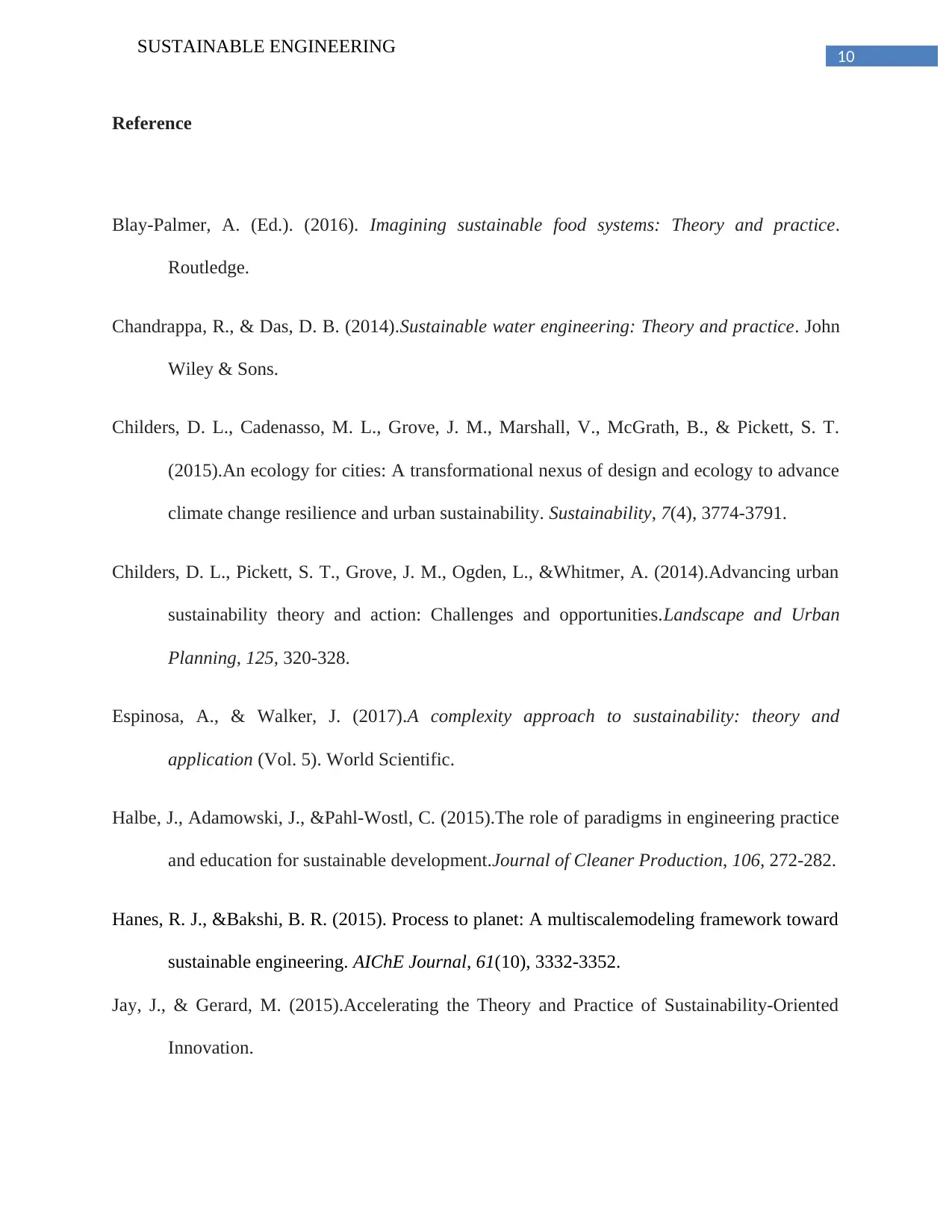
10
SUSTAINABLE ENGINEERING
Reference
Blay-Palmer, A. (Ed.). (2016). Imagining sustainable food systems: Theory and practice.
Routledge.
Chandrappa, R., & Das, D. B. (2014).Sustainable water engineering: Theory and practice. John
Wiley & Sons.
Childers, D. L., Cadenasso, M. L., Grove, J. M., Marshall, V., McGrath, B., & Pickett, S. T.
(2015).An ecology for cities: A transformational nexus of design and ecology to advance
climate change resilience and urban sustainability. Sustainability, 7(4), 3774-3791.
Childers, D. L., Pickett, S. T., Grove, J. M., Ogden, L., &Whitmer, A. (2014).Advancing urban
sustainability theory and action: Challenges and opportunities.Landscape and Urban
Planning, 125, 320-328.
Espinosa, A., & Walker, J. (2017).A complexity approach to sustainability: theory and
application (Vol. 5). World Scientific.
Halbe, J., Adamowski, J., &Pahl-Wostl, C. (2015).The role of paradigms in engineering practice
and education for sustainable development.Journal of Cleaner Production, 106, 272-282.
Hanes, R. J., &Bakshi, B. R. (2015). Process to planet: A multiscalemodeling framework toward
sustainable engineering. AIChE Journal, 61(10), 3332-3352.
Jay, J., & Gerard, M. (2015).Accelerating the Theory and Practice of Sustainability-Oriented
Innovation.
SUSTAINABLE ENGINEERING
Reference
Blay-Palmer, A. (Ed.). (2016). Imagining sustainable food systems: Theory and practice.
Routledge.
Chandrappa, R., & Das, D. B. (2014).Sustainable water engineering: Theory and practice. John
Wiley & Sons.
Childers, D. L., Cadenasso, M. L., Grove, J. M., Marshall, V., McGrath, B., & Pickett, S. T.
(2015).An ecology for cities: A transformational nexus of design and ecology to advance
climate change resilience and urban sustainability. Sustainability, 7(4), 3774-3791.
Childers, D. L., Pickett, S. T., Grove, J. M., Ogden, L., &Whitmer, A. (2014).Advancing urban
sustainability theory and action: Challenges and opportunities.Landscape and Urban
Planning, 125, 320-328.
Espinosa, A., & Walker, J. (2017).A complexity approach to sustainability: theory and
application (Vol. 5). World Scientific.
Halbe, J., Adamowski, J., &Pahl-Wostl, C. (2015).The role of paradigms in engineering practice
and education for sustainable development.Journal of Cleaner Production, 106, 272-282.
Hanes, R. J., &Bakshi, B. R. (2015). Process to planet: A multiscalemodeling framework toward
sustainable engineering. AIChE Journal, 61(10), 3332-3352.
Jay, J., & Gerard, M. (2015).Accelerating the Theory and Practice of Sustainability-Oriented
Innovation.
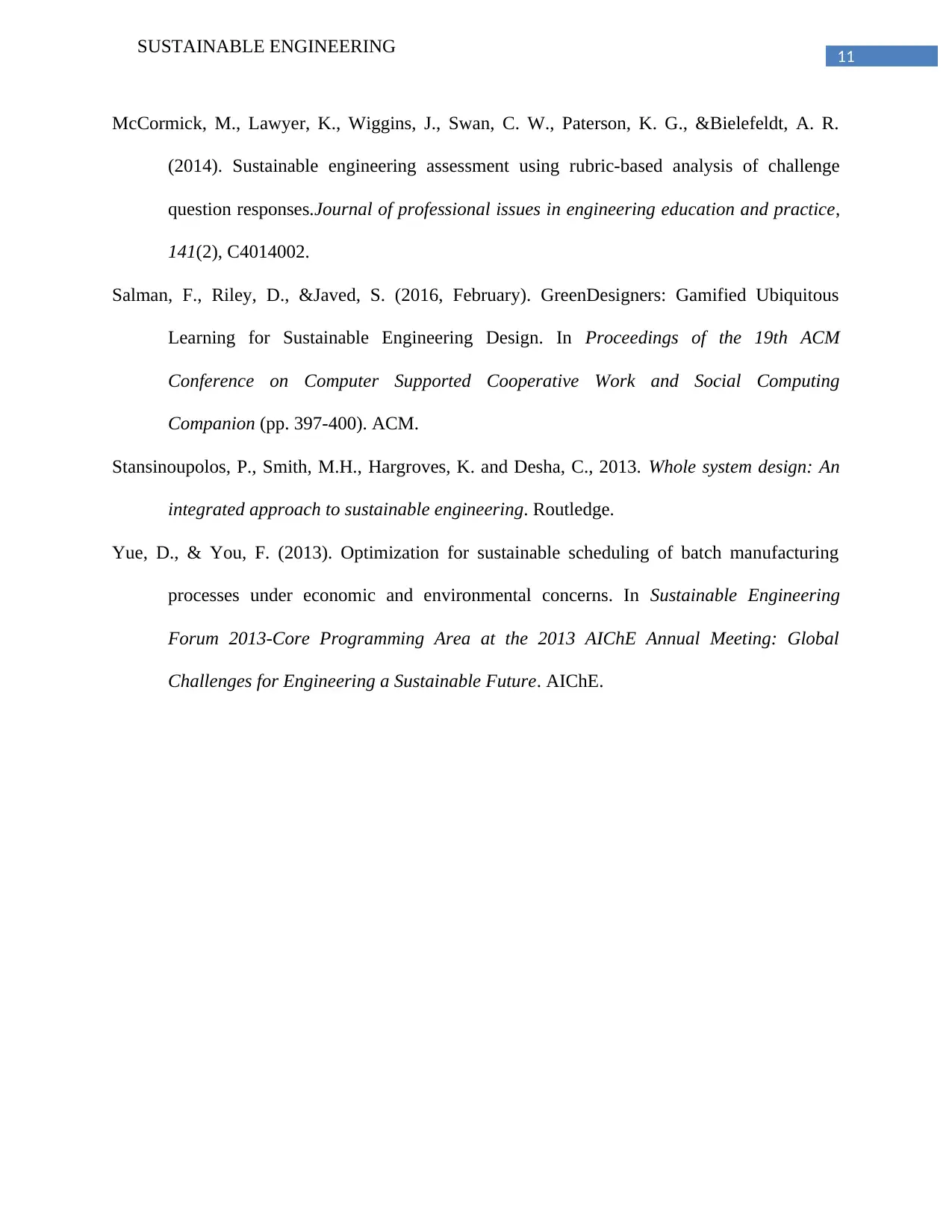
11
SUSTAINABLE ENGINEERING
McCormick, M., Lawyer, K., Wiggins, J., Swan, C. W., Paterson, K. G., &Bielefeldt, A. R.
(2014). Sustainable engineering assessment using rubric-based analysis of challenge
question responses.Journal of professional issues in engineering education and practice,
141(2), C4014002.
Salman, F., Riley, D., &Javed, S. (2016, February). GreenDesigners: Gamified Ubiquitous
Learning for Sustainable Engineering Design. In Proceedings of the 19th ACM
Conference on Computer Supported Cooperative Work and Social Computing
Companion (pp. 397-400). ACM.
Stansinoupolos, P., Smith, M.H., Hargroves, K. and Desha, C., 2013. Whole system design: An
integrated approach to sustainable engineering. Routledge.
Yue, D., & You, F. (2013). Optimization for sustainable scheduling of batch manufacturing
processes under economic and environmental concerns. In Sustainable Engineering
Forum 2013-Core Programming Area at the 2013 AIChE Annual Meeting: Global
Challenges for Engineering a Sustainable Future. AIChE.
SUSTAINABLE ENGINEERING
McCormick, M., Lawyer, K., Wiggins, J., Swan, C. W., Paterson, K. G., &Bielefeldt, A. R.
(2014). Sustainable engineering assessment using rubric-based analysis of challenge
question responses.Journal of professional issues in engineering education and practice,
141(2), C4014002.
Salman, F., Riley, D., &Javed, S. (2016, February). GreenDesigners: Gamified Ubiquitous
Learning for Sustainable Engineering Design. In Proceedings of the 19th ACM
Conference on Computer Supported Cooperative Work and Social Computing
Companion (pp. 397-400). ACM.
Stansinoupolos, P., Smith, M.H., Hargroves, K. and Desha, C., 2013. Whole system design: An
integrated approach to sustainable engineering. Routledge.
Yue, D., & You, F. (2013). Optimization for sustainable scheduling of batch manufacturing
processes under economic and environmental concerns. In Sustainable Engineering
Forum 2013-Core Programming Area at the 2013 AIChE Annual Meeting: Global
Challenges for Engineering a Sustainable Future. AIChE.
⊘ This is a preview!⊘
Do you want full access?
Subscribe today to unlock all pages.

Trusted by 1+ million students worldwide
1 out of 12
Related Documents
Your All-in-One AI-Powered Toolkit for Academic Success.
+13062052269
info@desklib.com
Available 24*7 on WhatsApp / Email
![[object Object]](/_next/static/media/star-bottom.7253800d.svg)
Unlock your academic potential
Copyright © 2020–2025 A2Z Services. All Rights Reserved. Developed and managed by ZUCOL.





